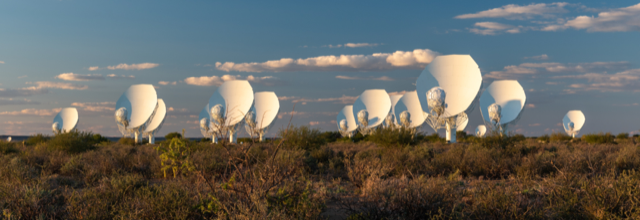Humans Help Computers Spot Bursts from Space
The ThunderKAT radio survey keeps constant tabs on objects, such as accreting black holes and magnetized neutron stars, that are known to exhibit big, sporadic changes in their radio flux. The survey also searches for new transient sources. Finding them is primarily done by computer algorithms, but given how good humans are at pattern recognition, the ThunderKAT team wondered if human volunteers could find new transients more effectively. The answer is yes. In a trial that lasted three months, 1000 volunteers discovered 142 new transients [1]. The effort could inform how future transient surveys should be conducted.
Astronomers have cataloged many types of transients, from x-ray bursters to cataclysmic variables. The variability of these objects arises from explosive, out-of-equilibrium processes under extreme conditions. To better understand these processes, the ThunderKAT team studies transient phenomena in the Southern Sky using MeerKAT, an array of 64 radio telescopes located at a remote site in South Africa’s arid interior. When MeerKAT points at a known transient, ThunderKAT’s algorithms search for other point sources in the array’s 1° × 1° field. If the algorithms find a new transient, the computer program then sifts through archive data to see if radio signals have been observed from the source location during previous MeerKAT observations. If so, the program assembles a light curve, which is a record of the radio flux over time. Whether the new source is classified as a transient depends on how it scores with respect to two variability statistics: 𝜂, which sums over the flux variations with respect to mean, and V, which divides the standard deviation by the mean flux.
The algorithms have identified many new transients, but the team decided to have humans look through some of the data to check whether any objects might have been missed. The data used in the trial extended over two years and came from weekly observations of 11 known transient sources. Within a three-month window, human volunteers evaluated candidates on the citizen science platform Zooniverse. For each candidate, the volunteers faced two tasks. The first was to look at an image and determine if the source in the center was a point source. (Extended sources are outside ThunderKAT’s remit.) The second task was to look at the corresponding light curve and evaluate whether the variability it embodied was significant.
The volunteers found the 168 sources that ThunderKAT’s algorithms had already flagged as transient. But they also found 142 more that the algorithms had missed. Those sources turned out to have values of 𝜂 and V that were insufficiently extreme to trigger selection by the algorithms. Humans, it seems, were better at recognizing the normal variability of faint sources.
Astronomer and citizen science proponent Lucy Fortson of the University of Minnesota, Twin Cities, points out that it’s not just pattern recognition that humans excel at. “Humans also need less training data for recognizing patterns,” she says. “They also generalize better and can recognize more readily patterns ‘out of class.’”
Some of the newly discovered sources turned out to have counterparts that had been observed before by other facilities at other wavelengths. One of them is the red supergiant star OH 30.1–0.7, whose radio emission comes from radiationally pumped hydroxyl radicals in the star’s strong wind. The variability of the radio emission suggests that OH 30.1–0.7 could have a binary companion, but other explanations remain in play.
Observations by the 24-inch MeerLICHT optical telescope, which is co-located with MeerKAT, suggest that the majority of the citizen science identifications are active galactic nuclei. The observed variability of these objects on timescales of months to years is likely not intrinsic. Rather, it arises from a more prosaic effect: refractive interstellar scintillation—twinkling—caused by the passage of extragalactic radio waves through the Milky Way’s turbulent interstellar medium.
Even if only a fraction of the new sources are found to be genuine transients, the ThunderKAT team can use the citizen science findings to tweak their algorithms. In addition, one of MeerKAT’s original goals is to test technologies for the similar, but much larger, Square Kilometre Array (SKA), whose 1000 antennas are expected to start gathering data in 2027. The researchers conclude that the success of ThunderKAT’s citizen science project will improve not only MeerKAT’s data-crunching algorithms but also SKA’s.
–Charles Day
Charles Day is a Senior Editor for Physics Magazine.
References
- A. Andersson et al., “Bursts from Space: MeerKAT - The first citizen science project dedicated to commensal radio transients,” arXiv:2304.14157; Mon. Not. R. Astron. Soc. (to be published).





